Ensuring the immaculate state of your car’s leather seats can prove to be quite a daunting endeavor, especially when faced with the predicament of stubborn residue. Whether it’s from a spilled drink, adhesive from a sticker, or residue from a cleaning product, the sight of an unsightly mark on your otherwise flawless leather seat can be upsetting. However, there’s good news: with the right approach and the appropriate cleaning agents, it is entirely possible to remove such stubborn stains without causing any harm to your leather seats.
What is Sticky Residue?
The issue of sticky residue arises when certain substances adhere to an object’s surface, posing a challenge for removal. This predicament can manifest on different surfaces, even extending to the likes of leather car seats.
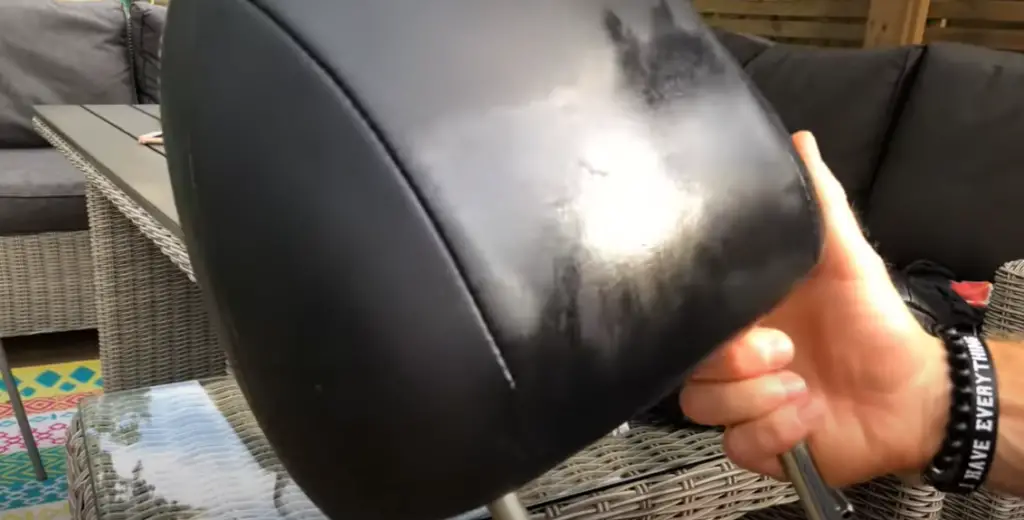
Causes of Sticky Residue on Leather Car Seats
There are several factors that can contribute to the appearance of sticky residue on your leather car seat. Here are some common causes: [1]
- Spills: Accidentally spilling sticky substances like soda or food on your leather car seat can result in a stubborn residue that is challenging to remove.
- Body oils and sweat: Over time, the natural oils present in our skin and sweat can accumulate on leather surfaces, leading to the development of a sticky residue.
- Cleaning products: Certain cleaning products may contain ingredients that, when used on leather surfaces, leave behind a sticky film.
- Heat and humidity: During hot and humid weather conditions, the natural oils in leather can rise to the surface, creating a sticky residue.
Removing Sticky Residue with Household Products
One of the most frequent frustrations experienced by car owners is dealing with sticky residue on their leather car seats. This can be caused by a variety of things, such as spilled drinks, food crumbs, or even sweat from hot summer days. No matter the cause, it’s important to get rid of this unsightly mess before it causes permanent damage to your car seats.
Luckily, there are several household products that can effectively remove sticky residue from leather car seats. In this section, we’ll discuss some of the most effective methods and ingredients to use.
White Vinegar
White vinegar is a versatile household staple that doubles as an effective cleaner for tackling sticky residue on leather car seats. To harness its power, simply combine equal parts vinegar and water in a spray bottle, then generously mist the affected area. Allow the solution to work its magic for a few minutes before gently wiping it away with a clean cloth. The natural acidity of vinegar aids in breaking down and dissolving the stubborn residue, leaving your car seats looking pristine.
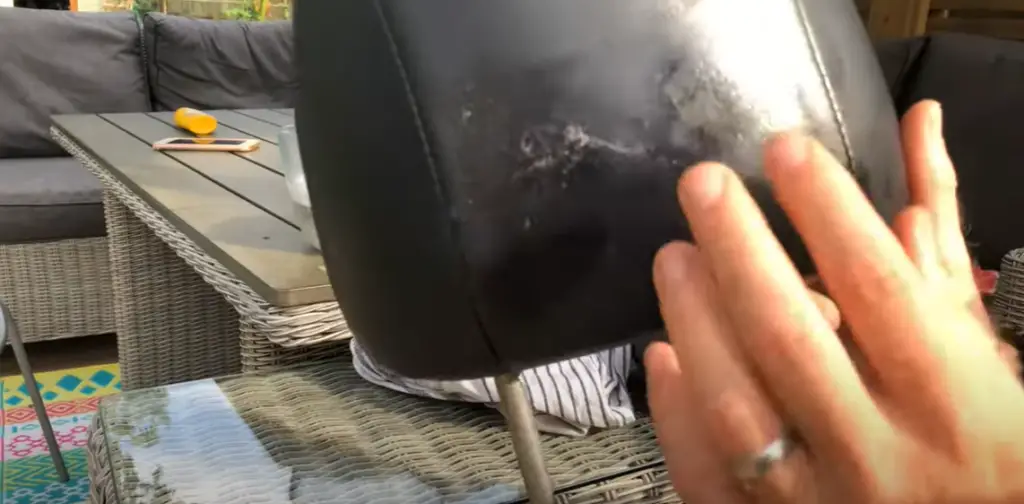
Baking Soda
Baking soda is a versatile household product that can effectively eliminate sticky residue from leather car seats. To make a paste, simply combine equal parts baking soda and water, and apply it to the affected area. Allow it to sit for approximately 10 minutes, then gently remove it with a damp cloth. Baking soda is renowned for its ability to absorb odors and oils, making it an excellent choice for cleaning stubborn residue. [2]
Rubbing Alcohol
Rubbing alcohol is a versatile disinfectant that can effectively eliminate sticky residue from leather car seats. To tackle this issue, dampen a cloth with rubbing alcohol and delicately rub it onto the affected area. The alcohol will facilitate the dissolution of the sticky residue, simplifying the wiping process.
Dish Soap
Dish soap is a highly effective cleaner for removing grease and grime from leather car seats. To tackle the issue, simply mix a small amount of dish soap with warm water. Then, gently scrub the affected area using a cloth. After that, rinse the area with clean water and dry it thoroughly with a towel. With this method, your leather car seats will be left looking clean and refreshed.
Tips for Removing Sticky Residue Effectively
- Prior to applying any household products on your leather car seats, it is always advisable to test a small, inconspicuous area first.
- Avoid using harsh chemicals or abrasive cleaners as they have the potential to cause damage to the leather.
- Opt for a soft cloth or sponge to gently scrub away any sticky residue, taking care to avoid applying excessive pressure.
- In the case of stubborn stains, repeat the cleaning process multiple times until the residue is completely removed.
With the help of these readily available household products and following these simple yet effective tips, you can effortlessly eliminate sticky residue from your leather car seats. Restore the pristine condition of your car while ensuring its longevity with these affordable and hassle-free cleaning methods. [3]
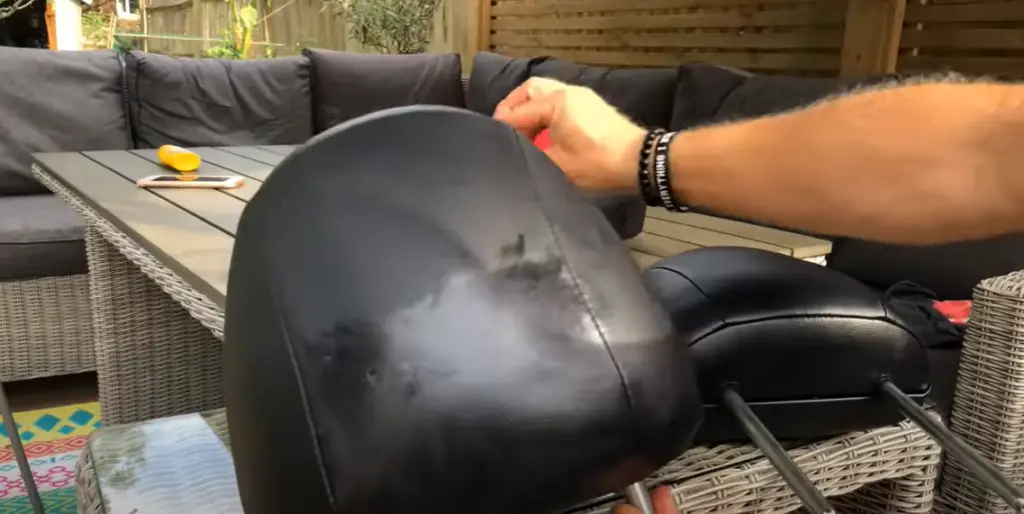
Preventing Sticky Residue on Leather Car Seats
Alongside learning how to effectively remove sticky residue from leather car seats, it is equally crucial to implement preventive measures to avoid encountering this problem altogether. Here are a few valuable tips to maintain the cleanliness and pristine condition of your car seats, ensuring they remain free from any unwanted sticky residue.
- Make it a habit to regularly vacuum your car seats to remove crumbs or debris that can lead to sticky residue buildup.
- It’s best to avoid eating or drinking in your car, especially if you have leather seats.
- Keep a small towel or wipes handy in your car to quickly clean up any spills.
- Consider using seat covers or protective mats to create a barrier between your skin and the leather seats and prevent direct contact.
Why Should You Remove Sticky Residue From Your Leather Car Seat?
Your car is more than just a means of transportation; it’s an investment. To ensure its longevity and appeal, it’s crucial to maintain the pristine condition of your leather car seats and prevent any sticky residue from accumulating. By doing so, not only will your vehicle look more appealing, but you’ll also safeguard its value.
Removing sticky residue from your leather car seat not only improves the appearance of your car but also ensures that your seats are properly maintained for long-term use.
Effects of Sticky Residue on Leather Car Seats
Sticky residue on your leather car seats can have a range of negative effects. Not only does it make your car look dirty and unsightly, but it can also lead to long-term damage if left untreated.
Over time, sticky residue can degrade the quality of the leather, causing it to become dry and cracked. This not only affects the appearance of your car but also reduces the durability and lifespan of your leather seats. [4]
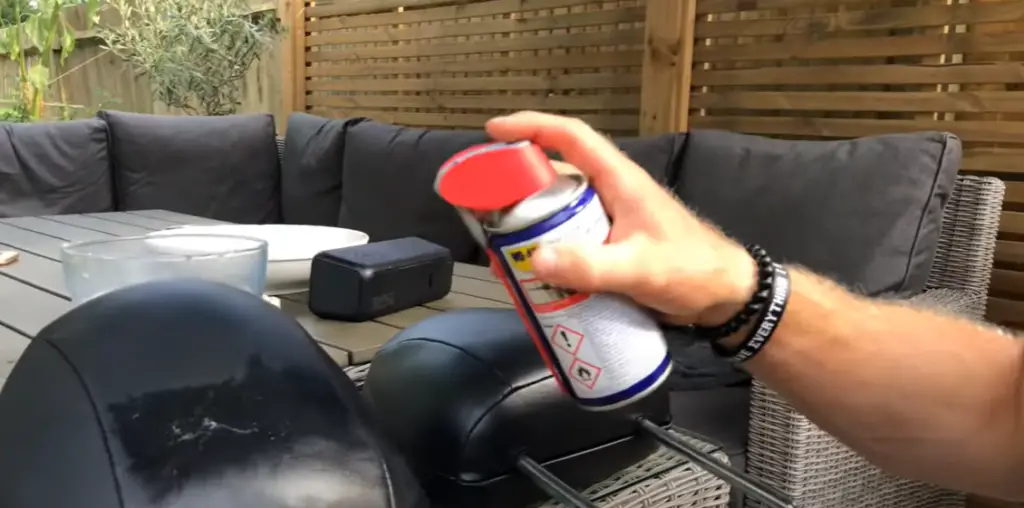
Types of Sticky Residue on Leather Car Seats
Throughout the years, leather car seats have become a staple in many vehicles. Unfortunately, these comfortable and stylish seats are prone to collecting sticky residue that can be tough to remove. There are various types of sticky residue that can accumulate on your leather car seat, and each one requires a different approach for removal.
Types of Sticky Residue:
- Food Stains: From spilled drinks to dropped food, sticky food residue can easily find its way onto your leather car seat. If not cleaned up immediately, these stains can become tough to remove and leave a sticky residue behind.
- Sweat: As the weather gets warmer, we tend to sweat more while sitting in our cars. This sweat can seep into the leather and create a sticky residue that can be challenging to remove.
- Body Oils: Our skin naturally produces oils, and when we sit in our cars, these oils can transfer onto the leather seats. Over time, this buildup of body oils can create a sticky residue that needs to be cleaned regularly.
- Chemical Residue: If you use cleaning products on your car’s interior, some residue may be left behind on the leather seats. This residue can dry and create a sticky film that is tough to remove.
- Dirt and Dust: Dirt and dust particles can easily collect on your leather car seats, especially if you have young children or pets. As these particles accumulate over time, they can mix with spills and oils and create a sticky residue. [5]
How Does Vinegar Destroy Leather?
Vinegar is a common household product used for cooking and cleaning. This versatile liquid is known for its acidic properties, making it effective in removing tough stains and odors. However, when it comes to using vinegar on leather, there are mixed opinions on whether or not it can cause damage.
To understand how vinegar may affect leather, we must first understand the composition of leather. Leather is made from animal hide and is made up of collagen fibers that give it strength and durability. When exposed to acids, the collagen fibers in leather can break down, causing damage such as discoloration, stiffness, and even tears.
When vinegar comes into contact with leather, its acidic properties can start to weaken these collagen fibers. This process is known as acid hydrolysis. As the vinegar penetrates into the leather, it can also dissolve any natural oils present in the leather, further weakening its structure.
Aside from causing damage to the collagen fibers, vinegar’s acidic nature can also cause a chemical reaction with some dyes used on leather. This can result in discoloration or fading of the dye, making it difficult to restore the leather to its original color.
In addition, vinegar can also dry out leather, making it more prone to cracking and peeling. This is especially true for older or already damaged leather, as the acidic properties of vinegar can further deteriorate its condition.
So how can vinegar be used to remove sticky residue from a leather car seat without causing damage? The key is dilution. By diluting vinegar with water and using a soft cloth to gently blot the affected area, you can minimize the potential damage to the leather. [6]
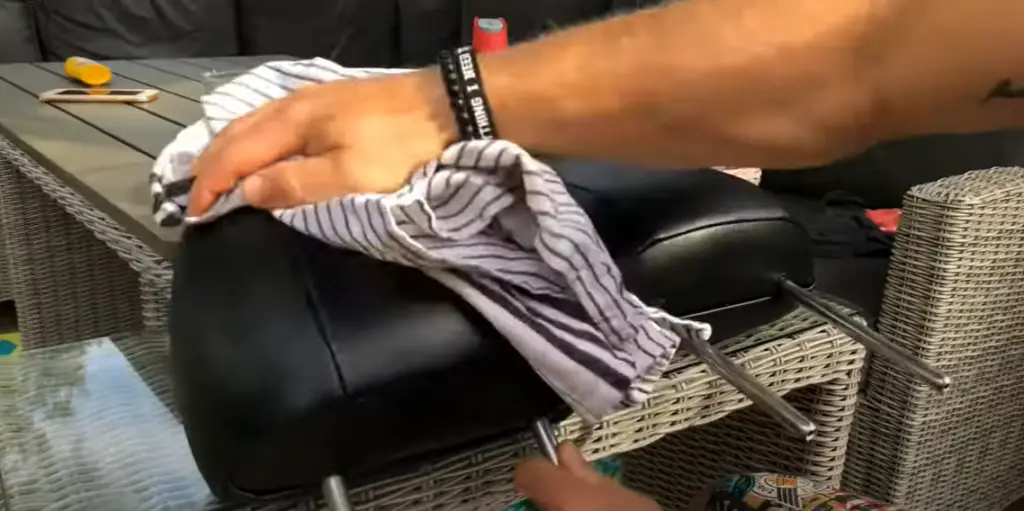
Is Rubbing Alcohol Bad For Leather?
When it comes to cleaning leather, there are a lot of different solutions that can be used. One common household item that people often turn to is rubbing alcohol. However, when using rubbing alcohol on leather, many people wonder if it is actually bad for the material.
The answer to this question isn’t so straightforward. Rubbing alcohol can have both positive and negative effects on leather, depending on how it is used. In this article, we’ll take a look at the potential effects of rubbing alcohol on leather and provide some tips for safely using it to clean your leather car seats.
How Rubbing Alcohol Can Affect Leather
Rubbing alcohol is known for its disinfectant properties and ability to cut through tough stains. However, when used on leather, it can have both positive and negative effects. Here are some ways that rubbing alcohol can affect your leather car seats:
- Removing Sticky Residue: One of the main benefits of using rubbing alcohol on leather is its ability to dissolve sticky residue. This makes it a great solution for removing things like gum or adhesives from your leather car seats.
- Disinfecting: Rubbing alcohol is also effective at killing bacteria and germs on leather surfaces. This can be especially useful if you have kids or pets that often ride in your car.
- Drying Out Leather: While rubbing alcohol does a great job of removing stickiness, it can also dry out leather if not used properly. If too much rubbing alcohol is used or if it is left on the leather for too long, it can strip away oils and moisture from the material. This can cause the leather to become dry, cracked, and damaged over time.
- Removing Color: Another potential issue with using rubbing alcohol on leather is that it can remove color from certain types of leather. If your car seats are made of dyed leather, using rubbing alcohol can cause the color to fade or even rub off completely.
Tips for Safely Using Rubbing Alcohol on Leather
If you do decide to use rubbing alcohol on your leather car seats, here are some tips to keep in mind:
- Dilute It: To avoid drying out your leather, it’s important to dilute rubbing alcohol before using it. A good ratio is one part rubbing alcohol to three parts water.
- Test on a Small Area: Before applying rubbing alcohol to your entire leather car seat, test it on a small, inconspicuous area first. This will give you an idea of how the leather will react and whether or not it is safe to use on the entire surface.
- Use a Soft Cloth: When applying rubbing alcohol to leather, always use a soft cloth or sponge. Avoid using abrasive materials like paper towels or scrub brushes, as these can damage the leather.
- Wipe Away Residue: After using rubbing alcohol on your leather car seats, be sure to wipe away any residue with a clean, damp cloth. This will help to remove any excess alcohol and prevent it from drying out the leather. [7]
Does Baking Soda Damage Leather?
Baking soda is another common household item that can be used for cleaning and removing stains from various surfaces. However, when it comes to leather, many people wonder if using baking soda can actually cause damage to the material. Let’s take a closer look at how baking soda can affect leather and whether or not it is safe to use on your car seats.
The Effects of Baking Soda on Leather
Baking soda is known for its ability to absorb odors and remove stains. However, when used on leather, it can have both positive and negative effects. Here are some ways that baking soda can affect your leather car seats:
- Absorbing Stains and Odors: One of the main benefits of using baking soda on leather is its ability to absorb stains and odors. This makes it a great solution for removing things like coffee spills or pet smells from your car seats.
- Lightening Leather Color: Similar to rubbing alcohol, baking soda can also remove color from certain types of leather. If you have light-colored leather car seats, using baking soda as a cleaning solution may cause the color to fade or lighten over time.
- Abrading Leather: Baking soda can also have abrasive properties, which can be damaging to leather. If used too vigorously or with a rough sponge, baking soda can cause scratches and wear on the surface of the leather.
Tips for Using Baking Soda on Leather
If you decide to use baking soda on your leather car seats, here are some tips to help prevent damage:
- Test on a Small Area: As with any cleaning solution, it’s important to test baking soda on a small area of your leather car seats before using it on the entire surface. This will help you determine if it is safe to use and how the leather may react.
- Use a Soft Cloth: Just like with rubbing alcohol, it’s important to use a soft cloth or sponge when applying baking soda to leather. This will help prevent any abrasive damage to the material.
- Vacuum Away Residue: After letting the baking soda sit for a few minutes, be sure to thoroughly vacuum it up with a fine-bristled brush or attachment. This will help remove any remaining baking soda and prevent it from causing damage to the leather.
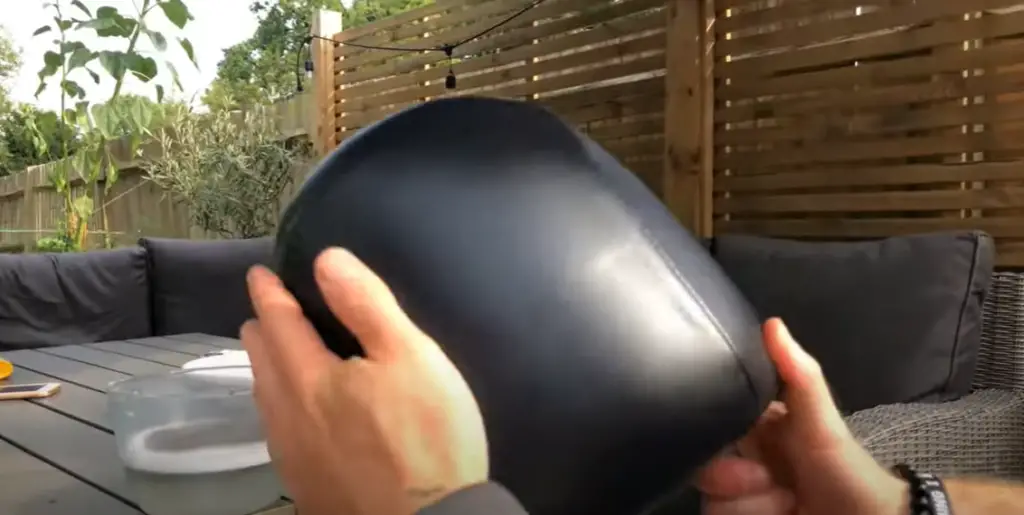
FAQs
What is the best way to remove sticky residue from a leather car seat?
The best way to remove sticky residue from a leather car seat is to use rubbing alcohol. Dilute the rubbing alcohol with water, apply it to a soft cloth, and gently rub the residue until it dissolves. Be sure to wipe away any excess residue and dry the area thoroughly.
Can I use baking soda on all types of leather?
Baking soda can be used on most types of leather, but it’s always best to test it on a small area first. Some types of leather may react differently to baking soda and could become damaged or discolored.
How often should I clean my leather car seats?
It is recommended to clean your leather car seats at least once every three months. However, if you have pets or children who frequently ride in your car, you may need to clean them more often. It’s important to regularly remove any dirt, debris, and spills from your leather seats to prevent damage and maintain their appearance.
Are there any specific products recommended for cleaning leather car seats?
Yes, there are many products specifically designed for cleaning and maintaining leather car seats. Some popular options include leather cleaners, conditioners, and protectants. It’s important to choose a product that is safe for use on your specific type of leather and to follow the instructions carefully. You can also consult with a professional at a car detailing or upholstery shop for recommendations on the best products for your leather car seats.
Can using harsh cleaning products damage my leather car seats?
Yes, using harsh cleaning products can potentially damage your leather car seats. It’s important to avoid abrasive materials and harsh chemicals that can strip the natural oils from the leather or cause scratches. Always use gentle cleaners and test them on a small area before applying them to the entire surface of your car seats.
What precautions should I take when cleaning sticky residue from leather car seats?
When cleaning sticky residue from leather car seats, there are a few precautions you should take to avoid damaging the material:
- Always test any cleaning solution on a small, inconspicuous area first.
- Use gentle cleaners and avoid abrasive materials.
- Gently rub the residue with a soft cloth or sponge instead of scrubbing vigorously.
- Wipe away excess residue and dry the area thoroughly.
- If using rubbing alcohol, be sure to dilute it with water and use a mild solution.
Can I prevent sticky residue from accumulating on my leather car seats?
Yes, there are a few ways to prevent sticky residue from accumulating on your leather car seats:
- Regularly clean and maintain your car seats by wiping them down with a soft cloth or vacuuming them to remove any debris.
- Avoid eating or drinking in the car, especially sticky or greasy foods which can leave residue on the seats.
- Use protective covers or seat protectors to shield your leather seats from spills and stains.
- If a spill does occur, promptly clean it up with a gentle cleaner to prevent sticky residue from forming.
Useful Video: How to remove sticky stuff from leather
Conclusion
In conclusion, the process of removing sticky residue from leather car seats can be quite simple and straightforward. By following the steps outlined in this guide, you should be able to effectively remove any sticky residue without damaging your leather car seats.
Remember to always start with a gentle cleaner or solvent before moving on to more harsh methods. This will help protect the integrity of your leather while still effectively removing the residue.
If you encounter any stubborn residue, don’t panic. There are plenty of specialized cleaners and techniques available for tougher jobs.
Additionally, it’s important to regularly clean and maintain your leather car seats to prevent the build-up of sticky residue in the first place. This will not only keep your car looking clean and pristine, but also extend the lifespan of your leather seats.
We hope this guide has been helpful in teaching you how to remove sticky residue from your leather car seats. Now, you can confidently tackle any sticky situations that may arise without worry or stress. Happy cleaning!
References:
- https://www.carwashcountry.com/how-to-remove-sticky-residue-from-car-leather-or-vinyl/
- https://carseatlover.com/how-to-remove-sticky-residue-from-leather-car-seat/
- https://autoguidehub.com/how-to-remove-sticky-residue-from-leather-car-seat/
- https://diyquickly.com/how-to-remove-sticky-residue-from-leather-car-seat/
- https://www.leatherskill.com/how-to-remove-glue-from-leather-car-seats/
- https://getjerry.com/questions/how-do-i-remove-glue-from-leather-car-seats
- https://littleeagles.edu.vn/26-how-to-remove-sticky-residue-from-leather-car-seat-quick-guide/

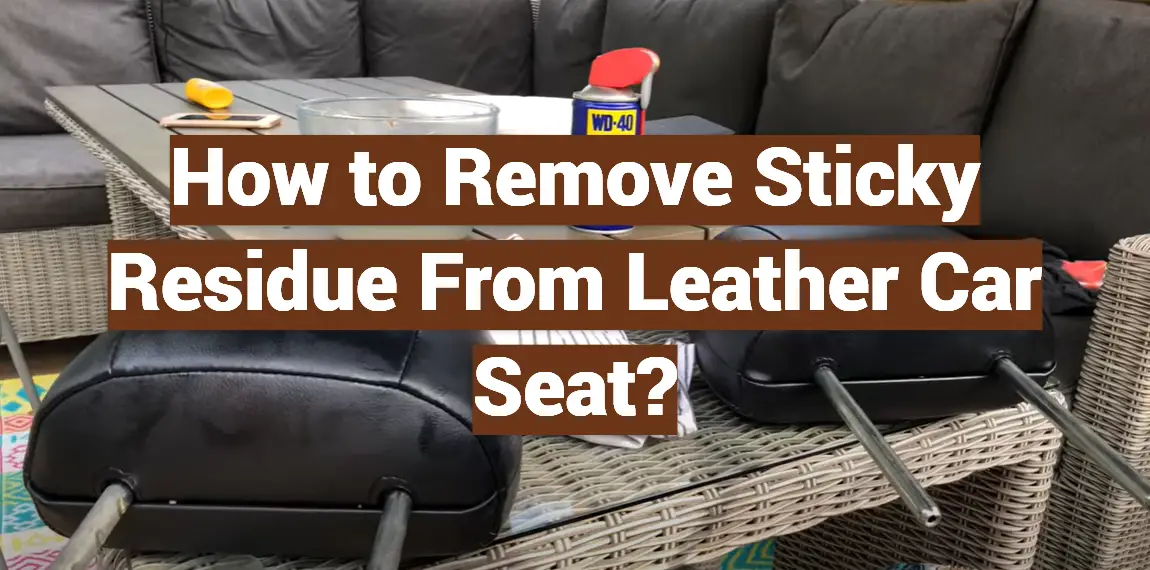





Leave a Reply